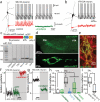Oxidant stress evoked by pacemaking in dopaminergic neurons is attenuated by DJ-1
- PMID: 21068725
- PMCID: PMC4465557
- DOI: 10.1038/nature09536
Oxidant stress evoked by pacemaking in dopaminergic neurons is attenuated by DJ-1
Erratum in
-
Corrigendum: Oxidant stress evoked by pacemaking in dopaminergic neurons is attenuated by DJ-1.Nature. 2015 May 21;521(7552):380. doi: 10.1038/nature14487. Nature. 2015. PMID: 25993967 No abstract available.
Abstract
Parkinson's disease is a pervasive, ageing-related neurodegenerative disease the cardinal motor symptoms of which reflect the loss of a small group of neurons, the dopaminergic neurons in the substantia nigra pars compacta (SNc). Mitochondrial oxidant stress is widely viewed as being responsible for this loss, but why these particular neurons should be stressed is a mystery. Here we show, using transgenic mice that expressed a redox-sensitive variant of green fluorescent protein targeted to the mitochondrial matrix, that the engagement of plasma membrane L-type calcium channels during normal autonomous pacemaking created an oxidant stress that was specific to vulnerable SNc dopaminergic neurons. The oxidant stress engaged defences that induced transient, mild mitochondrial depolarization or uncoupling. The mild uncoupling was not affected by deletion of cyclophilin D, which is a component of the permeability transition pore, but was attenuated by genipin and purine nucleotides, which are antagonists of cloned uncoupling proteins. Knocking out DJ-1 (also known as PARK7 in humans and Park7 in mice), which is a gene associated with an early-onset form of Parkinson's disease, downregulated the expression of two uncoupling proteins (UCP4 (SLC25A27) and UCP5 (SLC25A14)), compromised calcium-induced uncoupling and increased oxidation of matrix proteins specifically in SNc dopaminergic neurons. Because drugs approved for human use can antagonize calcium entry through L-type channels, these results point to a novel neuroprotective strategy for both idiopathic and familial forms of Parkinson's disease.
Figures




Comment in
-
Neurodegenerative disease: SNc neurons' Achilles heel.Nat Rev Neurosci. 2011 Jan;12(1):6. doi: 10.1038/nrn2968. Nat Rev Neurosci. 2011. PMID: 21218575 No abstract available.
References
-
- Albin RL, Young AB, Penney JB. The functional anatomy of disorders of the basal ganglia. Trends in neurosciences. 1995;18:63–64. - PubMed
-
- Schapira AH. Mitochondria in the aetiology and pathogenesis of Parkinson's disease. Lancet Neurol. 2008;7:97–109. - PubMed
-
- Chan CS, et al. ‘Rejuvenation’ protects neurons in mouse models of Parkinson's disease. Nature. 2007;447:1081–1086. doi:nature05865 [pii]10.1038/nature05865. - PubMed
Publication types
MeSH terms
Substances
Grants and funding
LinkOut - more resources
Full Text Sources
Other Literature Sources
Molecular Biology Databases
Miscellaneous

